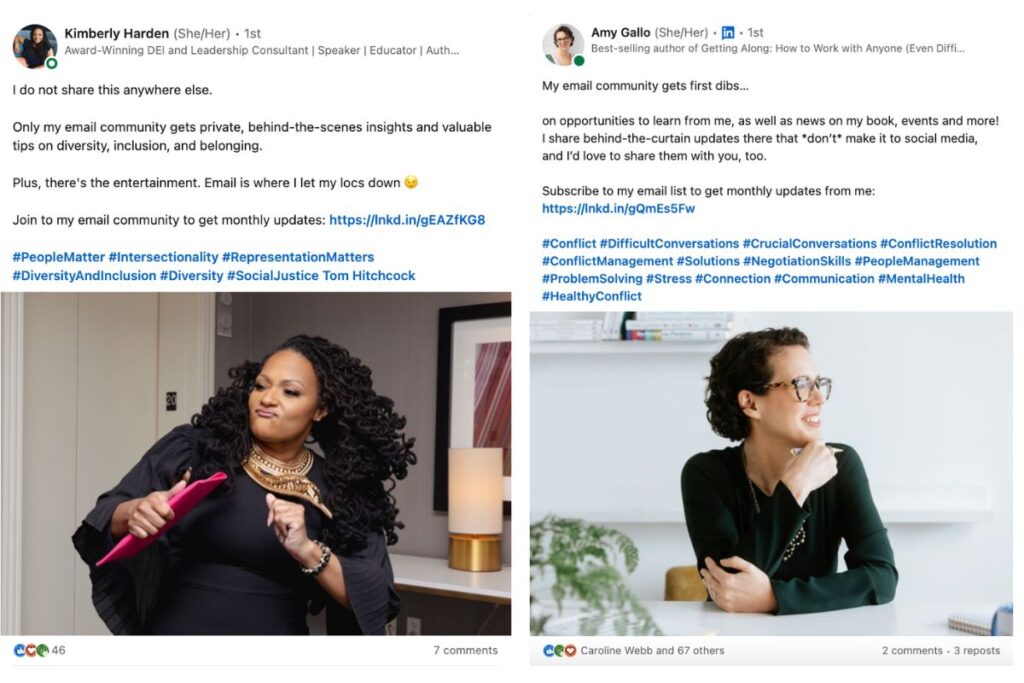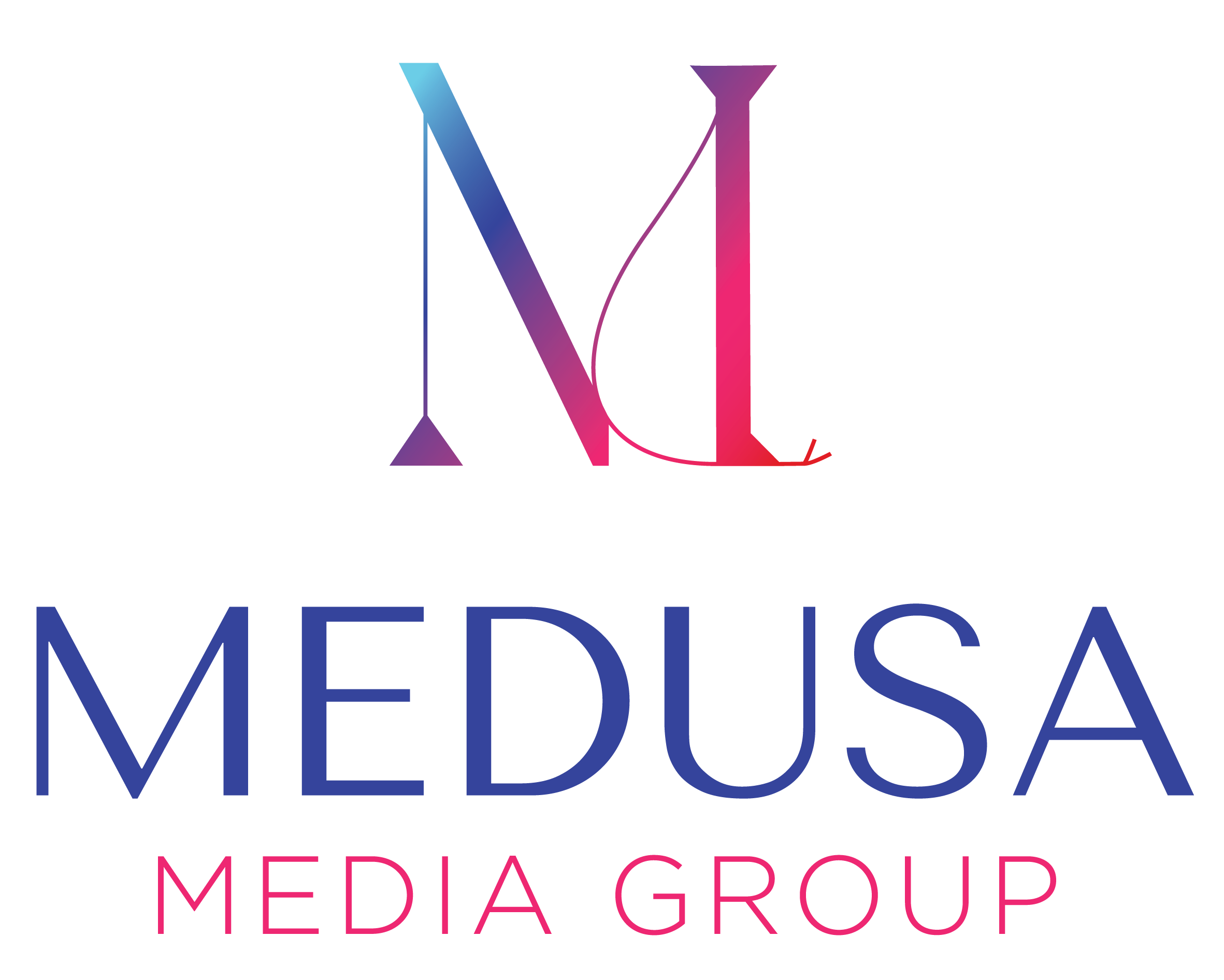If you want to grow your email list consistently, you might wonder: what do I need to do differently? What shiny tactic is the magic solution to a slow growth rate?
Or, as a client wrote:
“It’s fabulous that I doubled my LinkedIn followers last year, but in the same amount of time I only grew my email list by 9%. What strategies could I employ to change that?”
– Medusa Thought Leader Client
I could sense that she felt sheepish: was she missing something obvious? Should she already know the answer?
And, as she said when we sat down to talk about it: “you work with so many high-profile, successful women thought leaders. Are they doing something that I’m not?”
I hear this question often, and the answer is nearly always “no.” No, our #1 selling authors, highly-paid keynote speakers, and sought-after consultant clients aren’t employing some magical tactic to grow their email list that everybody else is missing.
How to Grow your Email List
The truth is more simple and complex: to see improvement in the “outer resonance” of your thought leadership — that is, the rate at which and how your audience grows by resonating with your work — requires a series of small and valuable tweaks (rather than one dramatic change) to how you distribute your work and invite people into your world.
In other words: if you are unsatisfied with the growth rate of your email list, start by mending the leaks in your bucket.
And by “bucket” I mean the journey or funnel that transitions someone from a stranger to a subscriber, or citizen of your world.
Here’s how:
1. Know Your Numbers
Before you glare accusingly at the growth rate of your email list, make sure you’re looking at the right numbers.
In our client’s case, 9% was the *net* growth of her list in a year. It was the total number of new subscribers, minus the total number of people who unsubscribed.
Her total number of new subscribers (her gross growth rate) was higher than 9%. Gross = total new subscribers. Net = new subscribers minus subscribers lost.
It’s valid to desire a higher net growth rate than 9%, but can you see how your gross growth is different from your net growth? Once we differentiated the two and our client could see how many total new subscribers she’d earned, she felt better about the number of new people she was attracting.
2. Embrace Healthy Churn
“Churn” is the word for the rate of people unsubscribing from your list. Churn is healthy and normal. It’s your thought leadership doing its job: repelling people who aren’t a fit for you, and engaging people who are.
Your churn rate will depend on:
- Size: the size of your list (the larger your list, the more unsubscribes you can expect per email you send)
- Frequency: how often you send emails
- Relevancy: If you have a legacy list that you built over 10 years, and you’re now pivoting your work and sending thought leadership about different topics, you can expect a high number of unsubscribes in the beginning of that transition.
- Re-engagement: how often (and how) you re-engage subscribers who don’t often open your emails. Re-engagement is a “whole nother topic” that I’ll write about separately.
Even though churn is healthy and normal, allow me to confess that every time someone unsubscribes from my list, I feel a pang of rejection. That’s healthy and normal, too! Even when you understand intellectually that churn is healthy, it can still hurt and that’s okay.
For further normalizing: I just chose two clients and calculated the churn rates of their lists (size ranging between a few hundred to a few thousand subscribers). The average was 0.7%. It’s not an apples-to-apples comparison (one client sends emails monthly, and the other bimonthly) but it’s a helpful ballpark.
3. Review your History of Growth
Do you know where your subscribers came from? Using tags in your ESP (email service provider, not extrasensory perception) can provide this data. In my case, over the last 30 days 35% of new subscribers came from “admin add,” 30% from our LinkedIn Profile lead magnet, 25% from Mailchimp’s API and 10% from our 5 Pillars lead magnet.
A word about “Admin Add”
As you can probably guess, this category is for users the Medusa team adds manually to our ESP. “Wow,” you might think. “That sounds like an enormous hassle. Can’t I automate it?”
In many instances, yes you can. But my philosophy is this: I want to make it as effortless as possible for someone to join my email list. I’m willing to have me and my colleagues do the extra work of manually adding a subscriber once we have their consent — rather than expecting them to click on a link and fill out their information and blah blah blah.
The more steps or complexity it requires to join your list, the more people will “fall off” and not do it.
4. Make it Effortless to Opt-in
This is where the “mend the leaks in your bucket, a.k.a. journey or funnel that transitions someone from a stranger to a subscriber, with small and valuable tweaks” rubber meets the road.
Let’s hearken back to the curse of knowledge for a sec. I bet you believe, on some level, that it’s fairly clear/obvious/easy/simple for someone to join your email list.
That’s the “curse of knowledge” at play: you created your email list so of course it’s obvious to you how to join…
- “You just scroll to the footer of my website.”
- “You just copy/paste the link in my profile’s About section.”
- “You just hang out on my website for 15 seconds until the pop-up appears.”
But for someone who is new to you — maybe they heard you on a podcast, or found your post on LinkedIn — there is nothing obvious about waiting around for your pop-up or trolling your profile for a pasteable link.
Thus, it’s part of your role as a thought leader to make it easy for people to connect with you and your work. How? Make it effortless for someone to subscribe to your list by putting opt-ins at every connection point:
- Reading a thought leadership blog post? Put an email opt-in at the bottom.
- Reading your LinkedIn profile? Add a URL to your email list landing page under your headline, in your Featured section, and in your About section.
- Listening to you on a podcast? Give listeners a short, memorize-able URL where they can join your list.
- Scheduling a consult call or Roundtable? Include an opt-in to subscribe to your list.
- Delivering a keynote? Put a short URL in your slides, or invite the audience to text “join” to a special number to automatically subscribe.
5. Invite Consistently
This might be the most overlooked area of opportunity for growing your email list: simply inviting people to join.
Why? Well, a number of reasons:
1. The curse of knowledge, again
We think it’s obvious how to join, and that people will if they want. This neglects the power and intimacy of making an invitation. It also ignores that it feels good for the recipient to be invited! It’s the difference between seeing an event on a flier and the organizer personally inviting you to join because they want you there.
2. Fear of rejection:
There’s no doubt that the more invitations you make, the more rejections you’ll receive. Even if you know, logically, that someone opting-out of your email list is good, it still hurts (see the section on churn, above).
3. Fear of being repetitive or “nagging”
Our parents taught us not to nag because nagging is annoying. Many of Medusa’s clients shy away from making consistent email invitations because they feel like they’re hounding people, or sounding like a broken record. But when it comes to growing your email list, repetition is POWERFUL, because:
- Your audience is growing all the time. Repeated invitations ensure that new people get the opportunity to join. This is particularly true when you are a frequent keynote speaker or podcast guest. We have a client who earned a trickle of new subscribers every time she made an invitation on LinkedIn…until one day, after a big podcast interview, she got over 100 new subscribers from the same LinkedIn invitation.
- The “marketing rule of 7” states that it takes seven interactions before someone is ready to convert. By that rule, a potential subscriber might need to see your invitation seven times (not to mention all your other content in between) before she’s ready to opt-in to your email list.
So how do you invite consistently? By making it effortless and everywhere. With our clients, we focus on:
- LinkedIn posts that regularly invite followers. See below for an examples from clients Kimberly Harden, an award-winning DEI and leadership consultant, and Amy Gallo, best-selling author of “Getting Along“.
- A LinkedIn headline link or featured post. See our free course Generate Leads with an Effective and Enticing LinkedIn Profile for how those work.
- Adding an opt-in to every Roundtable and event they host personally (currently our Roundtables and events software isn’t connected to our ESP — so we manually add folks who consent to opt-in. #WorthIt).
- Clear, easy-to-remember invites on podcasts. (For example, I invite listeners to a lead magnet with a short, easy-to-remember URL, but you don’t have to. You could simply invite listeners to yourwebsite.com/join!)

We also encourage clients to make it easy for keynote audiences, and for our many clients who are LinkedIn Learning instructors, we encourage them to have someone on their team follow up with every course-taker and invite that individual to join the email list.
Inviting LinkedIn Learners to join your email list
You could invite them by sharing a lead magnet or link with them and requesting they join… or you could ask if they would like to join, and manually add them yourself. (I have my suspicions about which would yield better results, but only experimentation will tell for sure!)
Go Forth and Grow Your Email List
I know this is a lot. “Grow your email list” is not something to check off your to do list once — it’s a lifestyle. It’s an ongoing practice of nurturing relationships and making your world accessible to the people who want to be part of it.
If you diligently put these “mend the leaky bucket” practices into place, you will grow your email list. While each tweak on its own might seem small, their cumulative effect is enormous.
Let your LinkedIn Profile Work for You
A few simple tweaks take your LinkedIn profile from “fine” to FINE 🔥 — and an effective LinkedIn profile is a huge boost when it comes to growing your email list and making that consistent, effortless invitation.
Our short, free e-course guides you to make simple and effective updates to your profile so it generates leads and opportunities and grows your network strategically. Let your profile work FOR you.
If you liked this article, share it LinkedIn! Copy/paste below:
If you’re unhappy with the growth rate of your email list, there’s good news:
Small tweaks are greater than a shiny new tactic.
In this article, @Eva Jannotta shares 5 simple tactics to “mend your leaky bucket” and improve your email list’s growth rate and consistently to earn new, interested, warm subscribers: https://medusamediagroup.com/your-email-list/grow-your-email-list-consistently-with-5-simple-tweaks/






